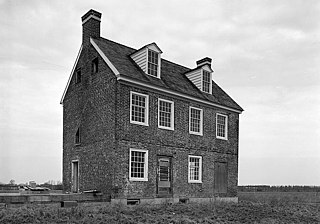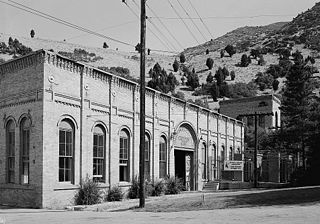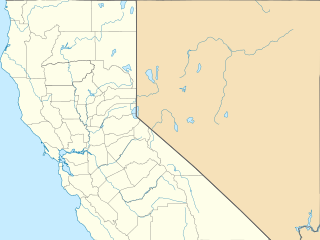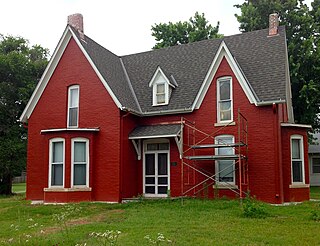
The Former Montana Executive Mansion, also known as the Original Governor's Mansion, is a property in Helena, Montana, listed on the National Register of Historic Places in 1970.

Oxon Cove Park and Oxon Cove Farm is a national historic district that includes a living farm museum operated by the National Park Service, and located at Oxon Hill, Prince George's County, Maryland. It is part of National Capital Parks-East. It was listed on the National Register of Historic Places in 2003.

The Jennings-Salter House, also known as the Michael Salter House, is a historic house located in Lancaster, Kentucky. The house was placed on the United States National Register of Historic Places in 1980.

Rockland, also known as Verdier Plantation, Schley Farm and Knode House, was built by James Verdier between 1771 and 1785 near Shepherdstown, West Virginia. Verdier was a Huguenot, the son of a French silk weaver, who married Lady Susanna Monei and came to North America to escape religious persecution. In America he became a tanner, with tanneries in Martinsburg, West Virginia, Sharpsburg, Maryland and Shepherdstown. His children founded Verdiersville, Virginia after his death. The older portion of the house is stone masonry. A brick Victorian style addition was built in 1897.

Chesterville Brick House, also known as Goodings Store, Isaac Spencer House and Salter House, is a historic home and former commercial building located at Chesterville, Kent County, Maryland. It is a 2 1⁄2-story brick building, thought to have been built about 1773. The building has changed ownership many times. It was originally located on the northwest corner of the intersection of Maryland Route 447 and Maryland Route 290, abandoned in 1970, and vandalized prior to being moved in 1973; approximately 250 feet from its original site.

Bear Island Light is a lighthouse on Bear Island near Mt. Desert Island, at the entrance to Northeast Harbor, Maine. It was first established in 1839. The present structure was built in 1889. It was deactivated in 1981 and relit as a private aid to navigation by the Friends of Acadia National Park in 1989. Bear Island Light was listed on the National Register of Historic Places as Bear Island Light Station on March 14, 1988.

Baker Island Light is a lighthouse on Baker Island, Maine, which is part of Acadia National Park. The light station was established in 1828 as a guide to the southern entrance to Frenchman Bay. The present tower was built in 1855; the well-preserved tower, keeper's house, and associated outbuildings were listed on the National Register of Historic Places in 1988.

'Brick House Farm, also known as the Richard Jarrell Farmhouse, is a historic home in Greensboro in Caroline County, Maryland, United States. It was built about 1823 and is a five-bay-long, two-story brick “I” house with a kitchen addition dating to the 1970s. The main house measures 41 feet 8 inches (12.70 m) long by 20 feet 1 inch (6.12 m) deep. It is one room deep and features a gable roof.

The Louisa County Courthouse in Wapello, Iowa, United States, was built in 1928. It was listed on the National Register of Historic Places in 1981 as a part of the County Courthouses in Iowa Thematic Resource. The courthouse is the fourth building the county has used for court functions and county administration.

The Simon Peter Eggertsen Sr. House is a historic house in Provo, Utah, United States. It is listed on the National Register of Historic Places. Now it has been repaired, repainted, and appointed with appropriate furnishings of the times, this home very much depicts pioneer design and craftsmanship. The Simon Peter Eggertsen Sr. House was designated to the Provo City Historic Landmarks Registry on March 7, 1996.

The Charles E. Davies House is a historic house located in Provo, Utah. It is listed on the National Register of Historic Places.

The Startup Candy Factory is a historic building located in Provo, Utah that is listed on the National Register of Historic Places. The first candy bars in the United States were produced here.

Farmington is a house near Charlottesville, in Albemarle County, Virginia, that was greatly expanded by a design by Thomas Jefferson that Jefferson executed while he was President of the United States. The original house was built in the mid-18th century for Francis Jerdone on a 1,753-acre (709 ha) property. Jerdone sold the land and house to George Divers, a friend of Jefferson, in 1785. In 1802, Divers asked Jefferson to design an expansion of the house. The house, since greatly enlarged, is now a clubhouse.
The Perkins Addition was a 13 house development in Salt Lake City, Utah. Ten of its houses survived in 1983 and nine were each individually listed on the National Register of Historic Places.

The Granite Hydroelectric Power Station was built in 1896-1897 in Big Cottonwood Canyon, about 6 miles (9.7 km) southeast of Salt Lake City, Utah, United States. The plant comprises the powerhouse, transformer house, a wooden conduit, penstocks, and a small dam. Like the Stairs Station upstream, it represents an intact high-head generating plant from the late 19th century.

The West Liberty Commercial Historic District in West Liberty, Iowa, United States, is a historic district that was listed on the National Register of Historic Places in 2002. At that time, it included 41 contributing buildings, six other contributing structures, and eight non-contributing buildings.

Allison Mansion, also known as Riverdale, is a historic home located on the campus of Marian University at Indianapolis, Marion County, Indiana. It was built between 1911 and 1914, and is a large two-story, Arts and Crafts style red brick mansion with a red tile roof. The house features a sunken conservatory, porte cochere, and sunken white marble aviary.

The Naylor House is a historic building located in Des Moines, Iowa, United States. Thomas Naylor was born in England and became a prominent grocer in Des Moines. He had this two-story brick Victorian house built in 1869. It is believed to have been designed by Des Moines architect William Foster. The house features an irregular plan, a combination gable-hip roof, two Carpenter Gothic wood porches, a bay window, pre-cast cement window hoods in an Eastlake design, paired roof brackets, and cornice returns on the gable ends. It remained in the Naylor family for almost 100 years. The house was listed on the National Register of Historic Places in 1974.

The Cheyenne Flour Milling Company, also known as the Standard Oil Company and Salt Creek Freightways, is an early warehouse building in Cheyenne, Wyoming. The structure was built in 1927 to house goods brought to and from Cheyenne by the Union Pacific Railroad in an industrial section of Cheyenne as a flour mill, replacing structures that had performed similar functions since 1915. By 1931 the building was shared by a warehouse for electrical parts for the Mountain States Telephone and Telegraph Company, a potato chip factory and a chemical products company. In 1937-38 the Standard Oil Company started to use the warehouse for bulk petroleum products storage, continuing to 1963. From 1963 the building was used by Salt Creek Freightways, which had shared use from 1936. In 1973 it became a plumbing parts warehouse, and by 2003 was owned and used by a general contractor.

The Locke House and Barn is a home and outbuilding in Lockeford, California that is now the Inn at Locke House. The house, built in 1858, the barn, built in 1852, and the water tower, built in 1887, were the first structures to be listed on the National Register of Historic Places in San Joaquin County, California when the property was added to the National Register in 1972.
























